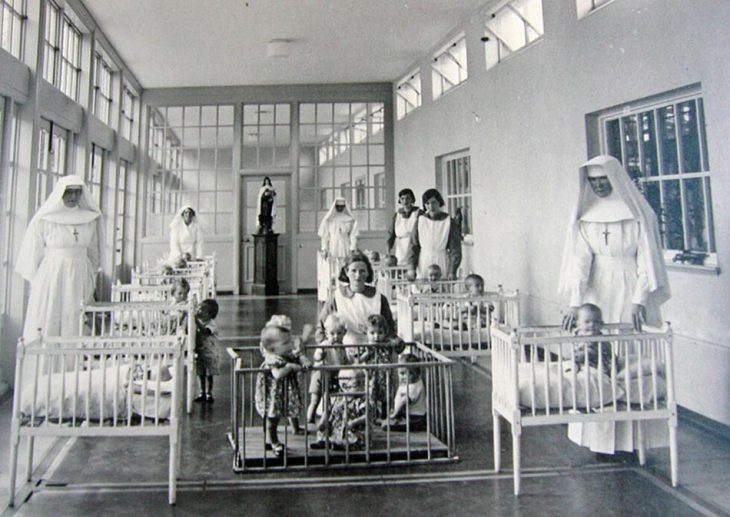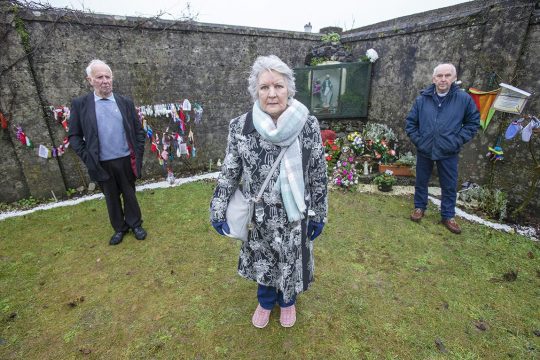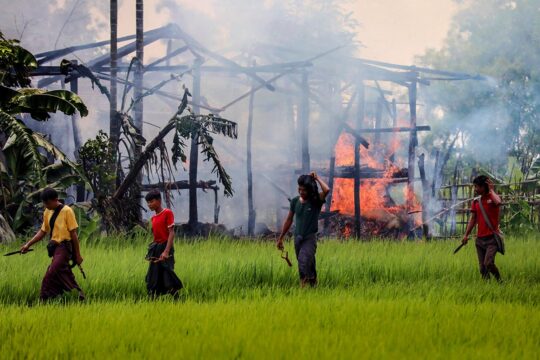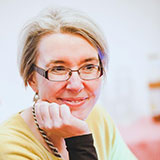“At [age] two and a half, my mother was given a half an hour's notice that I was going. She had knitted me my little clothes, ready if I ever should go. She had put those on me, and she walked me up the corridor to the nun who took me from there. And that was the last my mother was ever to see of me. I was handed over to two strangers, elderly strangers at that. And the nun came back and took my clothes back to my mother, who had so lovingly knitted them for me and said she won't be needing these. This was the kind of parting that really was such an emotional tragedy for women and children,” recounts Mary Harney in an interview on 16 April 2021.
On 12 January 2021 a six-year enquiry into mother and baby homes run by the church or the Irish state over several decades last century, came to an end with the release of a 3,000 page final report. It found that dozens of thousands of unmarried women were forced into such mother and baby homes. Thousands of babies died, their bodies in some cases unburied, with no certification, some thrown into cesspits. Illegal adoptions – such as Harney’s – were rife.
“They stripped us of our identities. They changed our names. They changed our mothers’ names. We can't find our birth certificates. If you're an ordinary citizen in Ireland, you can go get your birth certificate. If you're an ordinary citizen in Ireland, you probably go and access my birth certificate, but we can't. So they stripped us of identity, dignity, human rights,” says Harney, now 72 years old and a tutor at the Human Rights Law clinic at the National University in Galway.
The special committee concluded that Ireland was an “especially cold and harsh place for women '' at the time – mainly the 50’s, 60’s and 70’s – and unmarried mothers suffered serious discrimination. Societal attitudes are blamed: “Women who gave birth outside marriage were subject to particularly harsh treatment,” it says. And the report makes clear that the abuse was “supported by, contributed to, and condoned by, the institutions of the State and the Churches”.
It is the last of several investigations set up by the Irish state over recent years into linked institutions: child abuse within industrial schools into which children born in mother and baby homes were later educated; and the Magdalene Laundries network in which many mothers were forced to work. The report found that around 9000 babies died, about 15% - one in six - of all the babies born in these institutions. “The very high rate of infant mortality (first year of life) in Irish mother and baby homes is probably the most disquieting feature of these institutions. The death rate among ‘illegitimate’ children was always considerably higher than that among ‘legitimate’ children but it was higher still in mother and baby homes: in the years 1945-46, the death rate among infants in mother and baby homes was almost twice that of the national average for ‘illegitimate’ children,” it says.
“Women were told they were paying for their sins”
Yet the commission’s work has come under serious and widespread criticism among survivors and experts. “The Irish government is always making efforts to compartmentalise, to put boundaries around its investigations”, explains Maeve O’Rourke, director of the Human Rights Law Clinic at the National University of Ireland, Galway. “If you were born in one state-funded, church-run institution, you were very likely to have ended up in another one, if not another and another. Those affected have always made the point that it's wrong to investigate on an institution-by-institution basis. But that is what the government has done,” she says. It’s “a very piecemeal approach,” notes James Gallen lecturer at Dublin City University and Expert Advisor on Transitional Justice to the Department of Children and Youth Affairs on Mother and Baby Homes. Despite the clear “network of practises that may be deemed abusive,” he says, each survivor group or group of affected families has had “to start again in some respects,” he says, lobbying each time, to say to the state: “our issue, our group, our institutional setting matters, is also significant, and warrants investigation”.
Mary Harney was herself born in the Bessborough Mother and Baby home in 1949. In the year of 1944, the report says that up to 75% of babies born there died. Harney is outraged by what she sees as many defects in the committee’s report. The reports says that women admitted to the institutions ranged in age from 12 years old to women in their 40s. “A 12-year-old is not a woman. It is a child,” Harney says. “The commission admits that they were due to either incest or rape, and we have no investigation,” Harney points out. Her own mother was denied medical attention during the process of giving birth. “Women were told they were paying for their sin, that they were now to pay for what they did in a few minutes or that kind of demeaning, degrading treatment of women.” While the report admits the women “did suffer emotional abuse and were often subject to denigration and derogatory remarks,” and a “cold atmosphere”, it takes it no further. “I was appalled by the contradictory statements that were made in that report. On the one hand, there was abuse, but on the other hand, it wasn't really abuse,” says Harney.
Denying a respectful burial
The report says there was no evidence that the women were forced into institutions. “To say that women weren't incarcerated beggars belief,” says Harney. “These women had not committed any crimes. They were detained. This goes to the heart of human rights, enforced disappearance, trafficking of children by falsifying adoptions and falsifying information.”
One example that has gripped the Irish public imagination around the abuses is that of the Tuam mother and baby home in County Galway, where, in 2014, a substantial amount of human remains – many hundreds of bodies - was found in the grounds. “A local historian in Galway paid herself to gather every single death certificate that was in the general register office for a child who had died in the mother and baby home and then set about trying to find out where they were buried. We don't know how many of the babies are actually there but certainly there are many,” says O’Rourke. The structure in which dead babies were buried was formerly a septic tank. “Almost unbelievably, those babies are still in that place,” she says. While the mother and baby home report talks about a process of "respectful reburial", the process will not begin until 2022. “There has been nothing done for the actual individual families who wish to know: is my relative in the ground either in Tuam or another institution? what is the cause of their death?” O’Rourke continues. “There are actually people wondering if that death certificate is correct or [if their] relative [could] actually be adopted somewhere else. Was it actually falsified or not? We know in Ireland that many people's birth certificates were falsified. There was a whole process of illegal adoption. People's identities were completely obliterated. And so people are wondering: was that done with death certificates, as well in furtherance of transnational adoptions?”
A secret enquiry
O’Rourke is also deeply disappointed by how the committee has dealt with survivor testimonies. The report suggests that some testimony is contaminated “because the survivors seem to have met and spoken, but they don't say which bits of the testimony are contaminated [and] many of the survivors say that their testimony has not been repeated faithfully.”
Gallen describes the enquiry process as “ritualistic,” designed to “give survivors the feeling you've been heard. But really, we're going to take back control once we've heard you”. “It was essentially a secret enquiry because when it was set up in 2015, none of those people affected were given legal representation,” says O’Rourke. The enquiry “refused entirely on a blanket basis to give any survivor access to any of the evidence it was gathering. And it refused even to give people like Mary [Harney] a transcript of the evidence that they had given. And it wouldn't give anybody their personal data,” she says. “I gave [an affidavit] to the confidential committee and I never got a copy of that statement back yet”, confirms Harney.
The commission has made 53 recommendations, including compensation and memorialisation. But Harney’s previous experience with another of the investigations into industrial schools makes her even more sceptical of the government’s approach. “The compensation there was based on whether or not you could prove you were in the institution, which is going to be hugely difficult with the mother and baby institutions, because we can't get our records to say that we were there.”
Facing up to the past
“The very first thing the survivors and victims of these gross and systematic human rights violations [need] - which absolutely include torture and enforced disappearance - is information”, says O’Rourke. Ireland has a criminal justice system, a civil justice system, a system of coroner's inquest, freedom of information and is part of the Europe-wise rules on protection of privacy and access to your own information known as ‘GDPR’. But “survivors of these institutions have been systematically excluded from every single one of those systems,” she says.
The investigations were characterized by private hearings, with no “meaningful effort to see the sort of public outreach that you would see in transitional justice practise,” notes Gallen. Without the sort of “public theatrics of a truth commission hearing” where survivors testimonies are led in a way that is sympathetic to them, the long, technical report is seen by the state as essentially an assessment of “bureaucratic failure”, he says.
Once the report came out, the leader of the Catholic Church in Ireland, Archbishop Eamon Martin, said he accepted that the Church was part of a culture in which "people were frequently stigmatised, judged and rejected". He said: "For that, and for the long-lasting hurt and emotional distress that has resulted, I unreservedly apologise to the survivors and to all those who are personally impacted by the realities it uncovers." The Taoiseach (Irish Prime Minister) Micheál Martin said the report described a "dark, difficult and shameful chapter" of Irish history to which “we must face up” as a society and that women and children were treated “exceptionally badly”.
For Harney the apologies are not enough. “It's a whitewash, it's no use. What we want is an apology that says successive Irish governments trampled all over [our] human rights. And when we get that apology and then the findings and the recommendations are based in international human rights, then that's a part of justice. What is of paramount importance to us is that we have free and unfettered access to our identities,” she says. O’Rourke shares Harney’s frustration and dissatisfaction: “I just find it so upsetting that basically the survivors are actually in a worse position now than they were six years ago”.







